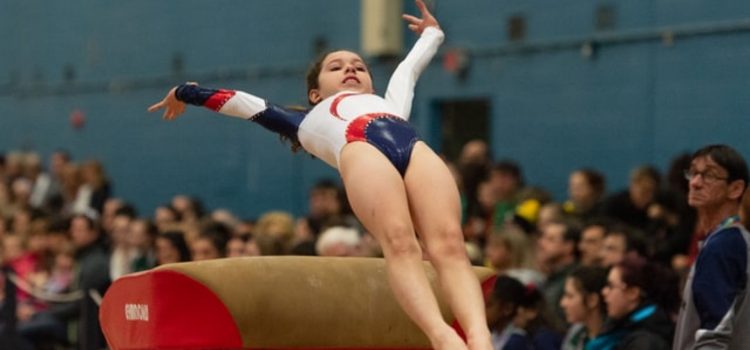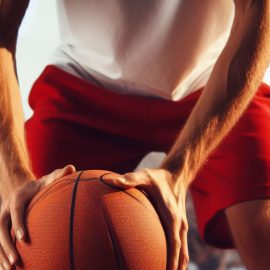

This article is an excerpt from the Shortform book guide to "The Sports Gene" by David Epstein. Shortform has the world's best summaries and analyses of books you should be reading.
Like this article? Sign up for a free trial here .
What is the best body type for gymnastics? Why is being small an advantage?
In a sport where athletes are often airborne and rotating, the laws of physics make being small in stature an advantage. Gymnasts also tend to have narrow hips, which is why gymnasts tend to be much younger than other Olympic athletes.
Keep reading to learn about the science behind the gymnastics body type.
Gymnastics and Body Type
Watching the opening ceremony of the Olympic games, it’s clear how small female gymnasts are compared to other athletes. The average height of a female gymnast is about 4 feet 9 inches, much shorter than the average American woman at 5 feet 4 inches, and certainly much shorter than athletes from other sports.
[Shortform note: Smaller athletes have smaller moments of inertia than larger athletes. This means that it takes less force for them to get their bodies moving into a flip, rotation, or spin than it would take a larger athlete. Larger gymnasts have to generate more force to complete the same movements. Larger athletes also have more mass farther away from their axis of rotation, which means that any rotation will require more force to initiate and will slow down faster (This is why figure skaters spin faster when they pull their arms into their bodies.)]Female gymnasts also have very narrow hips. Epstein cites the benefits of having a small, linear build as a primary reason female gymnasts are generally much younger than other Olympic athletes. Many elite female gymnasts peak in their teens and are considered “old” by the time they reach their twenties. Epstein notes that growth spurts and changes to a young athlete’s figure during puberty can be detrimental to a gymnast’s career.
[Shortform note: A study found that smaller gymnasts who had larger strength to weight ratios were better able to perform whole-body rotation skills than larger athletes. The study also found that as an athlete grew, her ability to perform specific skills (particularly back rotations) was negatively affected, while her ability to perform others was unchanged. (This may be because as athletes grow, they become more powerful, which can be an advantage for specific skills).]Epstein notes that female divers also have narrow hips, presumably for the same reason as gymnasts (their dives are entirely airborne and often include multiple rotations and flips).
| Does Gymnastics Stunt Growth? There is a long-standing belief that the years of intense training during a career in elite gymnastics both stunts athletes’ growth and delays puberty. Research on the topic is mixed but suggests more nuance than the idea that gymnastics “makes” athletes short. One study found that participating in gymnastics did not affect height or proportions in adulthood. This study also found no measurable ill effects on athletes’ endocrine system and found that the timing of puberty in gymnasts was on the late side of normal. Another study found that gymnastics did not affect leg length but may temporarily stunt “sitting height” (the length from trunk to head). But this change did not last into adulthood. A third study found that intense training of 18 hours per week did delay both growth and puberty, but that, while delayed, maturation still progressed typically. This study found that the delay was largely a function of energy output during training, with more intense training leading to more growth delays. (One of the main reasons that puberty is delayed is likely that hormones involved in puberty are regulated by fat tissue. Gymnasts train so hard and keep so lean that they don’t have much fat.) A meta-analysis involving gymnasts’ physiology suggested that it is likely that many young athletes gravitate to and continue to train in gymnastics because they found it to be a good fit for their naturally small body type. While there may be a component of training affecting physiology, the study suggests an element of self-selection that produces teams of smaller athletes. While the exact interplay of stature and training may remain mysterious, there is also an element of culture that affects gymnastics body type (specifically, size). The sport of gymnastics has come under intense criticism in recent years for subjecting young athletes to both mentally and physically unhealthy conditions. There is a growing call to shift the culture of the sport away from pushing athletes to peak so young and keep so lean. The new scoring system in gymnastics (which opens the potential for earning higher scores based on the difficulty of the skills performed) is allowing athletes with a less “linear” and more powerful and muscular build to shine, whereas in the past, the lightweight athletes with slim hips had often received higher scores. |

———End of Preview———
Like what you just read? Read the rest of the world's best book summary and analysis of David Epstein's "The Sports Gene" at Shortform .
Here's what you'll find in our full The Sports Gene summary :
- A look at how our genes play a determining role in our success in sports
- Why practice doesn't always guarantee success
- The fortuitous gene pairings that can lead to elite athleticism






